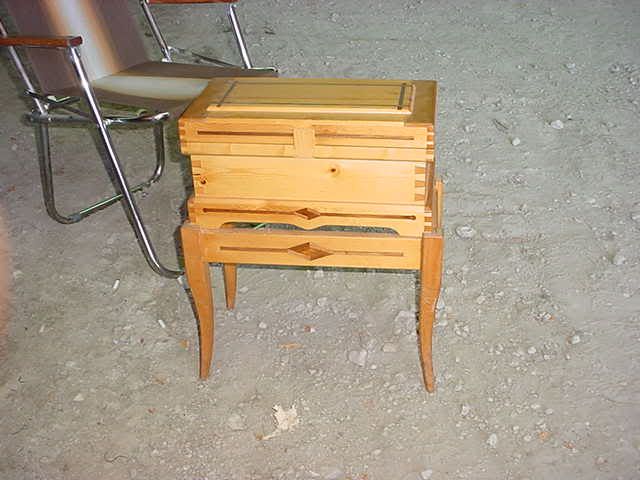David
Well done,you did a good job,well proportioned.......
David
Well done,you did a good job,well proportioned.......
I Love My Dedicated Machines ! And My Dedicated Wife Loves Me !
That's a fine looking piece of furniture! Nice design and very good execution. You can be proud of that piece for years to come. Thanks for sharing.
Stephen Edwards
Hilham, TN 38568
"Build for the joy of it!"
George, I realy appreciat the warning on the Tried & True, An will ask around what people think or have experienced with it! Also regarding the legs, are Queen Anne legs not cabriol legs? Would it make a difference?
Holy Cow!! That is good! Mr. Wilson may be correct about durability of the delicate proportions of the legs , but it sure looks right. I would be so proud to make a piece that beautiful.
Knowledge is Responsibility
Mark V.
David, you did an excellent job on this delicate table! You certainly didn't pick the easiest woods to work with for hand tools, but walnut and maple sure work well together, don't they?
Well done!
Louis Bois
"and so it goes..." Kurt Vonnegut Jr.
David - I can't explain how the leg's grain ended up the way they did if the grain in the rough outs was rift-sawn. The only way I can see that happening is if the grain rose on one end of the board, then descended on the other. That typically happens when the tree has a slight bend in it, and the saw at the mill "straightens it out". Those boards typically have a "bullseye" pattern somewhere in the middle.
David - "Queen Anne" legs were usually cabriole legs on chairs, highboys and lowboys. Chest and heavy case furniture typically got "bracket feet"."Also regarding the legs, are Queen Anne legs not cabriol legs?
But not all cabriole legs would be Queen Anne legs - the style carried over to Chippendale, and has been resurrected multiple times on more modern styles. You can still see bastardized cabriole legs on "traditional" mass-produced furniture like Ethan Allen. Those legs are really ugly because they're attentuated and made to fit the minimum stock size and be made by machine, but they're cabriole legs nonetheless.
I tend to agree with George, I happen to like Shaker Style and I particuly like the shaker tapered legs, I don't particuly care for turned legs, but rather like their tapered on the inside square legs. My personal rule of thumb is, I never taper the legs more than 1/3 of the original thickness. FWIW
My one exception to my rule was when I made the base for this sewing cabinet I made for my first wife to use while I was demoing Woodworking at Living History and Steam Shows. And there is no metal (screws or nails) use in its construction.

Last edited by harry strasil; 05-14-2009 at 11:39 AM.
Jr.
Hand tools are very modern- they are all cordless
NORMAL is just a setting on the washing machine.
Be who you are and say what you feel... because those that matter... don't mind...and those that mind...don't matter!
By Hammer and Hand All Arts Do Stand
David - Forgot to answer the "drawer blades"? question. A drawer blade is another word for a drawer divider - its the piece of wood that goes between each of the front legs to hold the drawer in the case. Generally, these are mortised into the front legs, or on a piece of case furniture, dovetailed into the case sides for the first couple of inches.
On most classically-designed furniture, the drawer blades are no thicker than 1/5th of the height of the smallest drawer, though there are some exceptions.
Thank you again David K., I will remember that for the next one(1/5 of the smallest drawer!) As for the blades on this project, I used stoped sliding dovetails to the front legs! Like i said this piece was to try as much joint as possible!!
David.
David - Remember that the 1/5th proportion is just a rule of thumb - on a particularly small piece, following that rule of thumb to the letter could result in a drawer blade that's too thin and flexes too much.
Using stopped sliding dovetails in the front legs would definitely be an unusual construction method (most pieces with longer legs have M&T joints connecting the blade to the leg), but there's certainly no reason why it won't work and be very sturdy. It's essentially the same grain orientation as found on early case pieces, where the drawer blade was connected to the case side with either a dovetail or a housed dovetail.
Interestingly, the aesthetic of the period demanded that joinery by hidden, so a lot of these case pieces have a piece of applied double-bead molding covering up the dovetails.